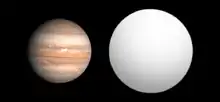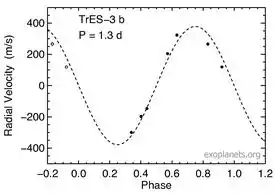TrES-3b
TrES-3b is an extrasolar planet orbiting the star GSC 03089-00929. It has an orbital period of just 31 hours and nearly twice the mass of Jupiter.
 Size comparison of TrES-3b with Jupiter. | |
| Discovery | |
|---|---|
| Discovered by | O'Donovan et al. |
| Discovery site | United States |
| Discovery date | 2007 |
| Transit | |
| Orbital characteristics | |
| 0.0226 ± 0.0013 AU (3,380,000 ± 190,000 km) | |
| 1.30619 ± 0.00005 d | |
| Inclination | 82.15 |
| Star | GSC 03089-00929 |
| Physical characteristics | |
Mean radius | 1.341 ± 0.081 RJ |
| Mass | 1.92 ± 0.23 MJ |
Mean density | 1,172 kg/m3 (1,975 lb/cu yd) |
| 2.7 g | |
| Temperature | 1555 K[1] |
The planet TrES-3b is named Umbäässa. The name was selected in the NameExoWorlds campaign by Liechtenstein, during the 100th anniversary of the IAU. In the local dialect of southern Liechtenstein, Umbäässa is a small and barely visible ant.[2][3]

Discovery
It is the third transiting planet found by the Trans-Atlantic Exoplanet Survey. It was discovered in the constellation Hercules about 10 degrees west of Vega, the brightest star in the summer skies.
Transits in front of the star GSC 03089-00929 were detected by two 10 cm telescopes operating out of Palomar and Lowell Observatories. Transits of TrES-3 were also independently observed by the Hungarian Automated Telescope Network. Seven high-precision radial velocity measurements were made using the HIRES spectrometer at W. M. Keck Observatory, which confirmed the presence of a planetary mass companion with a minimum mass twice that of the planet Jupiter.[4]
Characteristics
The planet's home star is slightly smaller and cooler than the Sun. The orbital period is less than one and a third days, one of the shortest known.[4] Despite close proximity to the star, no evidence of tidal-driven orbital decay was present as in 2020, with best data fit indicating only an apsidal precession of planetary orbit.[5]
References
- Saeed, M. I.; Goderya, S. N.; Chishtie, F. A. (2020), Multi-color photometry and parameters estimation of Jupiter-sized exoplanets; TRES-3b, WASP-2b and HATP-30b, arXiv:2011.07169
- "Approved names". NameExoworlds. Retrieved 2020-01-02.
- "International Astronomical Union | IAU". www.iau.org. Retrieved 2020-01-02.
- O'Donovan, Francis T.; et al. (2007). "TrES-3: A Nearby, Massive, Transiting Hot Jupiter in a 31-Hour Orbit". Astrophysical Journal Letters. 663 (1): L37–L40. arXiv:0705.2004. Bibcode:2007ApJ...663L..37O. doi:10.1086/519793. S2CID 17637874.
- Mannaday, Vineet Kumar; Thakur, Parijat; Jiang, Ing-Guey; Sahu, D. K.; Joshi, Y. C.; Pandey, A. K.; Joshi, Santosh; Yadav, Ram Kesh; Su, Li-Hsin; Sariya, Devesh P.; Yeh, Li-Chin; Griv, Evgeny; Mkrtichian, David; Shlyapnikov, Aleksey; Moskvin, Vasilii; Ignatov, Vladimir; Vaňko, M.; Püsküllü, Ç. (2020). "Probing Transit Timing Variation and Its Possible Origin with 12 New Transits of TrES-3b". The Astronomical Journal. 160 (1): 47. arXiv:2006.00599. Bibcode:2020AJ....160...47M. doi:10.3847/1538-3881/ab9818. S2CID 219176648.
External links
![]() Media related to TrES-3 at Wikimedia Commons
Media related to TrES-3 at Wikimedia Commons
- Massive Transiting Planet With 31-hour Year Found Around Distant Star
- Notes for planet TrES-3
- TrES-3 light curve using differential photometry